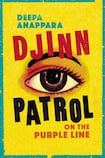
“When Mental was alive, he was a boss-man with eighteen or twenty children working for him, and he almost never raised his hand against any of them.” The opening line of Djinn Patrol on the Purple Line lands us straight into the world of India’s slums, in a debut novel that is teaming with life despite its deadly subject matter.
Deepa Anappara, the book’s author, is well placed to tell the story of the estimated 180 children who go missing each day in India. Born in the south of the country, she worked as a journalist in India for 11 years, reporting on human rights and education. Anappara has a masters in creative writing from the University of East Anglia, where she is currently doing a PhD. Her captivating debut is the winner of the Lucy Cavendish Fiction Prize, the Bridport Prize and the Deborah Rogers Foundation Writers Award.
Anappara shifts skilfully between different narrative voices throughout her novel. The opening section is related by a whipsmart “we” that shows the dire circumstances endured by thousands of street children, who come across as a kind of modern day Fagan’s boys, working and scheming for disreputable leaders in a bid to stay alive. Mental, as it turns out, is one of the good guys. He doesn’t mind if his boys fail to collect bottles, or even if they go to the cinema when they’re supposed to be working. But there are rules: if he catches them sniffing whitener, “their eyes swollen like full moons,” he stubs his Gold Flake Kings out on their wrists and shoulders and calls it “a waste of a good cigarette”.
It is a masterful eye-opener to the casual cruelties of contemporary India, which continue to be showcased with a switch to the first person voice of Jai, the book’s cheeky nine-year-old narrator. Jai’s family lives in the basti, one of India’s many slums, where adults work all day and children live in constant awareness of the poverty and dangers that surround them. That 180 figure is given as a regular warning by Jai’s headmaster, but words don’t go far enough in this place of heinous actions.
When a classmate Bahadar goes missing one day, Jai and his plucky friends, Pari and Faiz, set out to do some “detectiving”, a job that proves increasingly impossible as more children disappear. By the end of the book, we’ve come to know seven of these misfortunes, through short, deft third-person narratives: “The alleys of Bhoot Bazaar stretched around Bahadur like the gaping mouths of demons.” But the sad truth of Djinn, as one character memorably notes, is that these seven could easily be 70.
In the dark
The chief success of Anappara’s novel is her depiction of the basti, and the exploration of the cultural and societal issues that underpin it. Through the innocent eyes of Jai and his friends, the details are striking. Rich people live close to the slums “but seem far because of the rubbish ground in between”. The police come across terribly – negligent, corrupt, dangerous. From the police haftas, or bribes, to the taxes the pradhans place on business owners, to the children who skip school to work for peanuts, money – or the lack of it – governs the basti, a place where everyone is on the cadge.
With her vibrant rendering of an unequal, corrupt Indian society, there are echoes of Preti Taneja’s debut We That Are Young and the Booker-winning The White Tiger by Aravind Adiga, though the latter gives a more satisfactory closeness to one person’s character and perspective. In Djinn, while the stories are always interesting, they can appear fleeting, leaving us wanting to know more, which of course is a reflection of the subject matter and the thousands of families across India who are left in the dark about their loved ones.
A particular strength of Anappara’s writing is her portrayal of the plight of young Indian women. The curse of being beautiful is shown through the character of Aanchal: “The worst of them gestured at her crudely. Others whistled or surreptitiously raised their phones to click her photo.” Jai’s sister Runu-Didi, a competitive athlete, has “ruined her colour by running in the sun”. No one is safe in the basti at large but women fare badly even in the supposed sanctuary of their own home: “Right now, she was a not-good-enough daughter to her parents and, someday, she would be a not-good-enough wife to a strange man.”
The real not-good-enough in the world of Djinn are the incredibly brutal, everyday circumstances its characters are forced to endure. The djinn of the title are spirits in Indian culture that can do good or evil. Jai and his friends hope the missing children have been taken by one such spirit. By the end of Anappara’s novel, we ourselves will it to be true. At least then the families might have some hope of getting them home.











